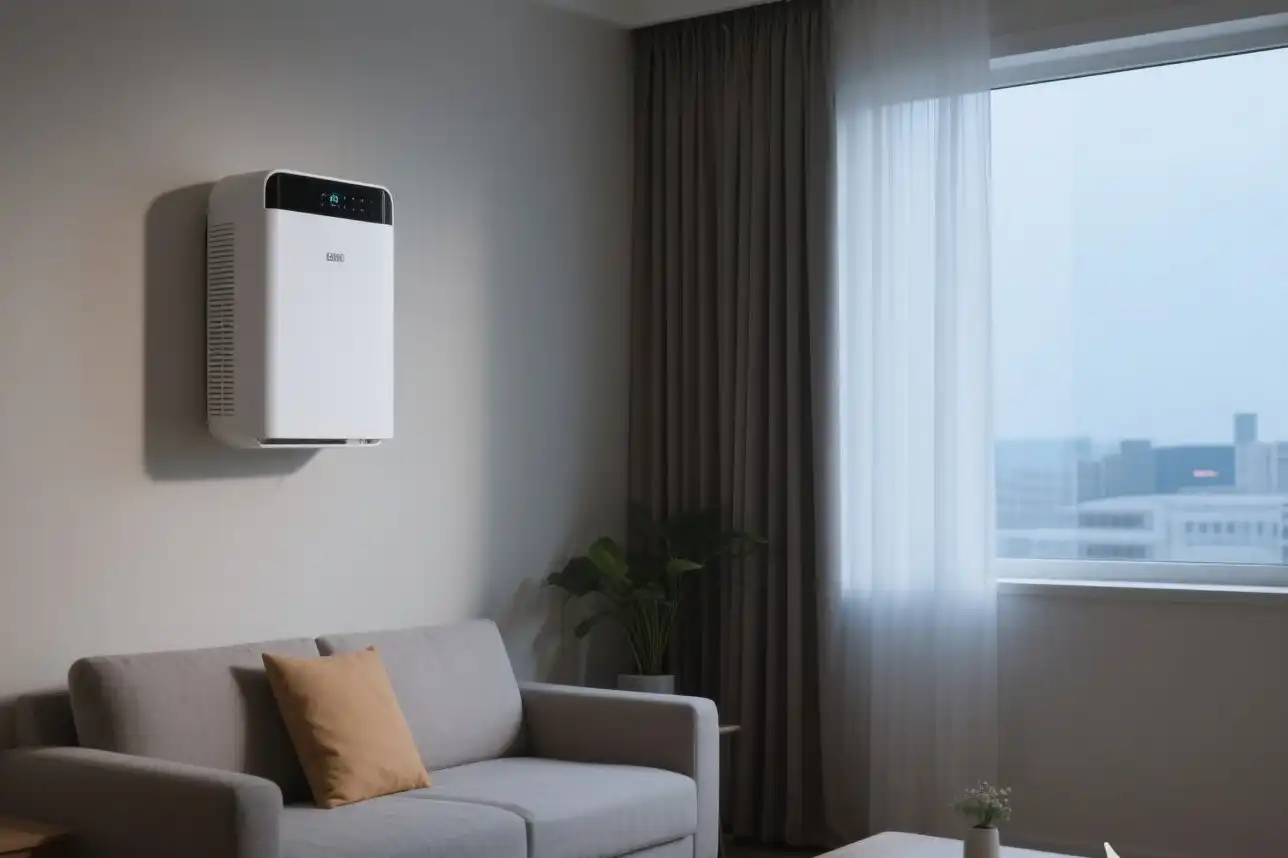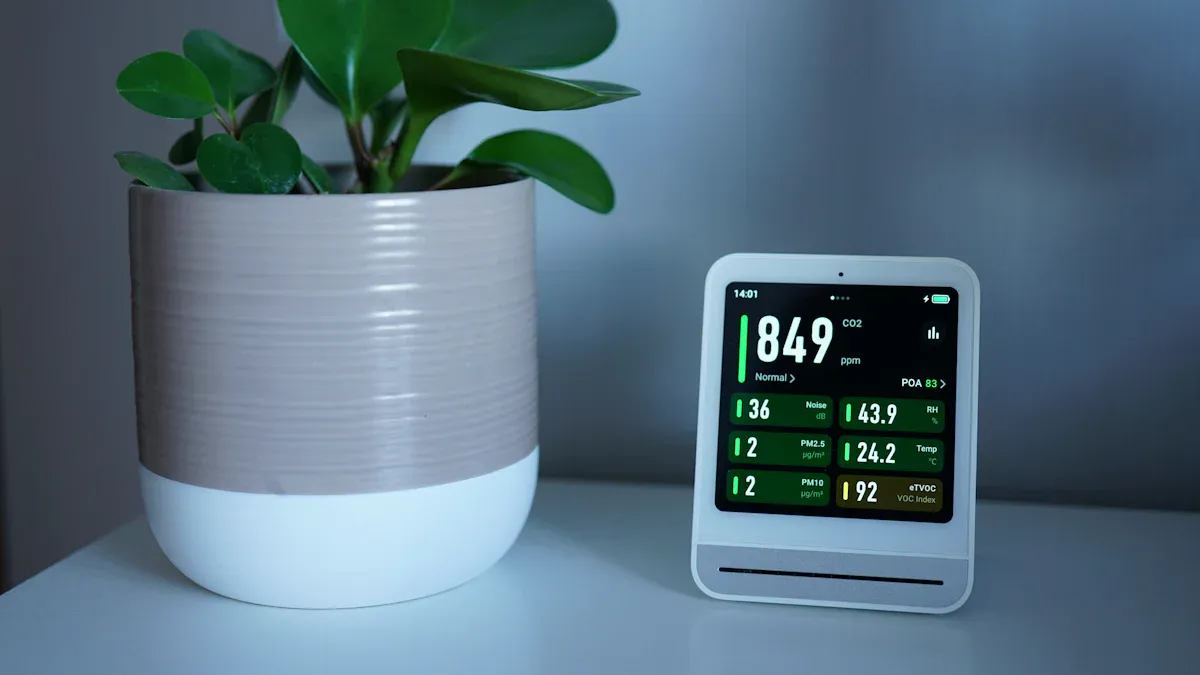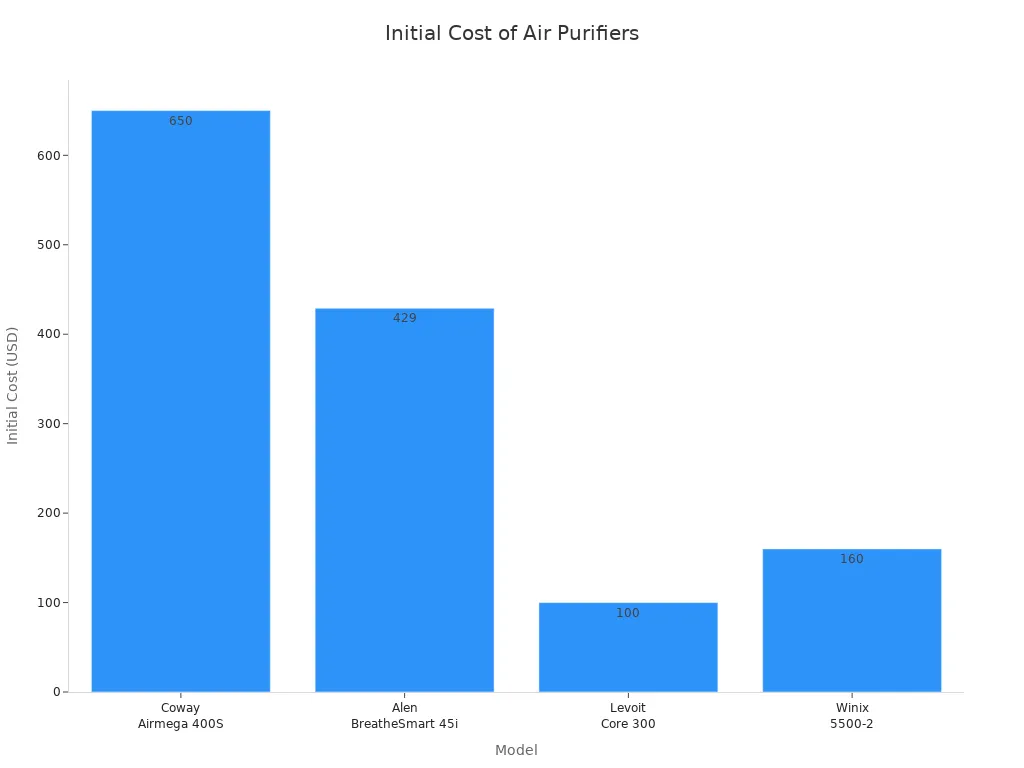
Not every room in your house needs an air purifier. You should use one in rooms where you spend a lot of time. You should also use one if you notice bad air. Bedrooms are important because you sleep there for many hours. Rooms with pets, bad smells, or allergies need help too. The table below shows where people put air purifiers and the reasons why:
| Room | Common Reason |
|---|---|
| Bedroom | Sleep quality, long exposure |
| Kitchen | Cooking odors, moisture |
| Living Room | Pets, dust, frequent activity |
Think about your home’s layout. Think about the size of each room. Think about what you need before you choose.
Key Takeaways
- Put air purifiers in bedrooms, living rooms, and kitchens. These are places where you spend a lot of time. Use them if you notice bad air in these rooms.
- Pick a purifier that matches the room size. Check the Clean Air Delivery Rate (CADR) to make sure it works well.
- Place purifiers where air can move easily. Put them near dust, odors, or allergens for best results.
- Use more than one purifier in big homes or houses with more than one floor. You should also use more if you have allergies, pets, or worry about wildfire smoke.
- Change filters often and choose quiet purifiers. This keeps your air clean and does not bother your comfort.
Air Purifier Placement
Bedrooms
You spend about one-third of your life in your bedroom. This makes it the most important place for an air purifier, especially if you have allergies or breathing problems. Dust mites and mold spores often collect in bedrooms. These allergens can make symptoms worse at night. Place the air purifier 3 to 6 feet from your bed, at mattress height. This setup helps clean air flow right into your breathing zone while you sleep. Choose a model with a true HEPA filter. HEPA filters remove 99.97% of tiny particles, including dust and pollen. Run the purifier all night to keep the air clean, since new pollutants appear even while you sleep. Pick a quiet model—one that runs below 30 decibels—so it does not disturb your rest. Make sure the purifier matches your room size by checking the Clean Air Delivery Rate (CADR). Studies show that using a HEPA air purifier in the bedroom can lower indoor pollution and help people with asthma or allergies sleep better.
Tip: Regular cleaning and filter changes help your air purifier work well in the bedroom.
Living Areas
Living rooms and family rooms see a lot of activity. You may have pets, visitors, or just spend time relaxing there. These spaces often collect dust, pet dander, and odors. Placing an air purifier in the living area can help reduce these pollutants. The right placement matters. Put the purifier where air flows freely, away from walls or large furniture. This helps it pull in dirty air and push out clean air. Research shows that a well-placed air purifier can lower fine dust (PM2.5) by more than half, especially when windows stay closed. Make sure you pick a purifier with a good CADR and change the filter on time. If you have pets, choose a model with both HEPA and activated carbon filters. These filters trap pet hair, dander, and smells. Using an air purifier in the living room can lead to fewer allergy symptoms and better air for everyone.
Note: Do not block the air purifier with furniture or curtains. This can lower its cleaning power.
Kitchens and Odor Zones
Kitchens create many indoor air problems. Cooking releases smoke, oil fumes, and strong smells. Odor-prone areas, like laundry rooms or spaces with litter boxes, also need attention. Place the air purifier near the stove or in corners with poor airflow. Elevate it on a counter to help it catch rising smoke and fumes. Avoid putting it right next to open windows or vents, as this can reduce its effect. Some purifiers have sensors that adjust to changes in air quality. These models work well in kitchens, where air quality can change quickly. Choose a purifier with both HEPA and carbon filters to trap particles and remove odors. Remember, cooking can clog filters faster, so check and replace them often. Using an air purifier in the kitchen or odor zones can make the air fresher and more comfortable.
- Place the purifier close to the source of odors or smoke.
- Keep it away from vents or open windows.
- Use a model with sensors for automatic adjustment.
- Clean or replace filters more often in these areas.
Tip: Air purifiers help, but you should also use fans or open windows to remove strong cooking smells when possible.
Room Size and Coverage

Matching Purifier to Room
You need to match the right air purifier to each room for the best results. Start by measuring the room’s square footage. Small rooms, like bathrooms or bedrooms, usually need coverage for about 200 square feet. Medium rooms, such as home offices or dining rooms, require purifiers that cover 201 to 399 square feet. Large rooms, like living rooms, need units that can handle 400 square feet or more.
The Clean Air Delivery Rate (CADR) helps you know if a purifier fits your space. Multiply the CADR by 1.55 to estimate the square footage it can cover. For example, a purifier with a CADR of 300 can clean about 465 square feet. Experts recommend choosing a purifier that gives you 2 to 5 air changes per hour. This means the air in your room gets cleaned every 12 to 30 minutes. If you have allergies or pets, pick a model with a higher CADR for better results.
Tip: Choose a purifier with a little more coverage than you need. This lets you run it on lower, quieter settings and still get clean air.
Open vs. Closed Layouts
Your home’s layout changes how well a purifier works. Open floor plans let air move freely between spaces. In these homes, one powerful purifier can often clean a large area. Place it in the center of the space and keep 3 to 5 feet of clear space around it. Use ceiling fans to help move clean air throughout the room.
| Layout Type | Airflow | Purifier Recommendation |
|---|---|---|
| Open Floor Plan | Air moves freely | One large purifier, placed centrally |
| Multiple Closed Rooms | Air blocked by walls | One purifier per room or floor |
If your home has many closed rooms, you need separate purifiers for each space. Walls and doors block airflow, so one unit cannot clean the whole house. For multi-story homes, use at least one purifier per floor.
Note: Place purifiers near sources of dust, odors, or allergens for the best results.
When to Use Multiple Air Purifiers
You might ask if you need more than one air purifier. The answer depends on your house and your family. Some homes need a few purifiers, but others do not.
Multi-Floor Homes
If your house has more than one floor, think about how air moves. Air purifiers cannot clean air on other floors or through closed doors. Experts say you should put a purifier on each floor or in each main room. This helps keep the air clean where you spend time.
- Big houses or homes with many closed rooms often need more than one purifier.
- Put purifiers in bedrooms, living rooms, and places with dust or smells.
- If your home is over 800 square feet, you may need a few purifiers to clean the air enough.
Tip: If you have just one purifier, move it to the room you use most.
Too many purifiers can cause problems. You might get dry air, higher bills, or dry skin and stuffy noses. Always use the right number of purifiers for your house.
Special Needs (Allergies, Pets, Wildfires)
Some families need extra help with air quality. If you have allergies, pets, or live near wildfires, you may need more than one purifier. Different rooms might need different filters.
| Need | Best Purifier Type | Key Features |
|---|---|---|
| Allergies | HEPA filter | Removes pollen, dust, mold spores |
| Pets | HEPA + Activated Carbon | Traps dander, hair, and odors |
| Wildfire Smoke | HEPA + Heavy Carbon Filter | Removes smoke, VOCs, and harmful gases |
People with asthma or breathing problems need strong filters. HEPA filters catch tiny things that can make you sick. Activated carbon filters take away smells and gases. Check and change filters often for the best results.
Note: Not every room needs the same purifier. Pick the right filter for each room’s problem.
Cost and Maintenance
Upfront Costs
When you plan to improve your home’s air quality, you need to think about the initial cost. You can choose between whole-house systems and portable units. Whole-house systems cost more at first, with prices ranging from $419 to $4,962. The average is about $2,610. Portable units cost less, usually between $100 and $1,000 each. If you want to put a unit in every room, you must add up the cost for each one.
| Air Purifier Type | Average Upfront Cost Range |
|---|---|
| Whole-House Air Purifier | $419 to $4,962 (avg. ~$2,610) |
| Portable Air Purifier | $100 to $1,000 per unit |
High-end models, like the Coway Airmega 400S, have a high list price but cover large spaces. Budget models, such as the Levoit Core 300, cost less and work well in small rooms. The chart below compares the initial costs of popular models:

Tip: You can save money by choosing budget models for small rooms and investing in high-end units for large spaces.
Filter Replacement
You must replace filters to keep your air clean. Most manufacturers recommend changing HEPA filters every 6 to 12 months. If you run your purifier all day or have pets, you may need to change filters more often. Some advanced models tell you when to replace filters. Carbon filters often need changing every 6 months. Regular filter changes help your device work well and keep your air fresh.
- Replace HEPA filters every 6–12 months.
- Change carbon filters about every 6 months.
- Check filters more often if you have pets or allergies.
Note: Always follow the manufacturer’s advice for your specific model.
Energy Use
Running a purifier uses electricity, but the cost is usually low. Most units use between 40 and 100 watts. For example, a 50-watt unit running all day uses about 1.2 kWh per day. This adds up to about $4.68 per month at average electricity rates. Energy Star models use even less power. Compared to large appliances like refrigerators, purifiers cost much less to run.
Tip: Use auto mode or timers to save energy when you do not need full power.
You do not have to put a purifier in every room. It is best to use them in bedrooms and main living spaces. These are the places where you spend most of your time. Research shows that putting purifiers in these spots helps air quality and health. It also saves energy and money. Make sure each purifier fits the size of the room. Think about how your home is set up for the best results. Take care of your purifier and put it in a smart spot. This helps you get clean air without spending too much or making things hard.
Remember: Bedrooms get the most from clean air. Living rooms and kitchens also get better when you use purifiers in problem areas.
FAQ
What rooms benefit most from an air purifier?
You get the most benefit in bedrooms, living rooms, and kitchens. These rooms collect dust, odors, and allergens. You spend a lot of time in these spaces, so clean air helps your health.
What size air purifier do you need for your room?
You should match the purifier’s coverage to your room’s square footage. Check the Clean Air Delivery Rate (CADR) on the label. Choose a model that covers a little more than your room size for best results.
What happens if you use too many air purifiers?
You may notice dry air, higher energy bills, or dry skin. Too many units can waste money and make your home uncomfortable. Place purifiers only where you need them.
What filters work best for allergies or pets?
You need a HEPA filter for allergies. For pets, use a purifier with both HEPA and activated carbon filters. These filters trap dust, dander, and odors.
What maintenance do air purifiers require?
You must change filters every 6 to 12 months. Some models have filter change alerts. Clean the outside of the unit with a damp cloth. Regular care keeps your purifier working well.
The following information may be of interest to you
How many air purifiers are needed for different room sizes
Whether one air purifier can be suitable for multiple rooms
